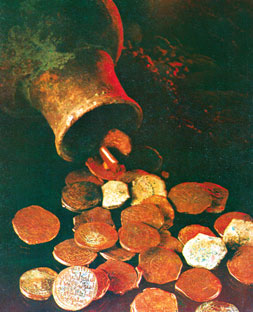 Pages 66-70
Pages 66-70by Kamil Ibrahimov
Coins provide valuable evidence of Baku´s history. Old coins and large quantities of ceramics have been discovered in recent years during construction work in the Old City (Icheri Sheher). The coins show that in ancient times Baku had a thriving economy and close commercial ties to other states. Copper and silver coins have been discovered in Baku during archaeological excavations and by chance by private individuals.
Even under the Sassanid Persian Empire Baku had commercial relations with neighbouring states, which can be seen from 83 silver Sassanid coins found in Baku. The oldest of them dates back to 542 AD, the 12th year of the rule of Sassanid King Khosrau I. The most recent of the coins was minted under Ardashir III in 629 AD.
Another important find unearthed 86 Sassanid silver coins, the oldest of which dates back to 490 AD, the fourth year of the rule of Kavadh I, and the most recent to the rule of Khosrau II in 638-639 AD.
Several treasure troves of Sassanid coins were unearthed on the territory of the former Baku Governorate and in other regions of Azerbaijan.
The first Arab coin found in Baku is an 8th-century Abbasid coin discovered in the Old City near what is now the Icheri Sheher metro station.
A Gold Dinar minted in the 207th year of the Islamic calendar (822-823 AD) was found seven or eight metres beneath the seabed near Baku port bridge during excavations. The find confirmed information in Arab sources about shipping in the first half of the 9th century.
Gold, silver and copper coins minted by the Abbasid caliphs were in circulation in Baku at the time. Ibn Hawqal, an Arab geographer of the 9th and 10th centuries, said that mostly gold and silver coins were in use in Azerbaijan.
Copper coins were minted in large numbers and were widely used in the 8th century. This shows the development of trade within the city and also between Baku and other towns. The coins also help to date other items discovered during archaeological excavations. Interestingly, most of the coins were minted in Baku. Researcher Sara Ashurbayli concluded that Baku had a mint in the Middle Ages.
Coins discovered in Baku were also minted in Shamakhi, Tabriz, Panahabad, Ganja, Derbent, Shabran, Mahmudabad, Iravan, Ani, Qizil Orda, Kashan, Sarai-al-Jadid, Bukhara, Qazvin, Soltaniyeh and other cities. This indicates that there were strong cultural and commercial relations between Baku and those cities in the Middle Ages.
Coins minted in Dar es Salaam with the names of several Abbasid caliphs have also been found in Baku. They include coins of Al-Mansur (754-755), Harun Al-Rashid (786-809), Al-Mamun (813-833) and Al-Wathik (842-847). Excavations unearthed copper coins minted by the Shirvanshahs; silver and copper coins minted by the Ildegaz, Seljuks and Ilkhanids; silver and copper coins minted by the Qaraqoyunlu, Agqoyunlu and Safavids; and coins minted by the 18th-century Azerbaijani khanates.
As there has been no systematic archaeological research, it has been impossible to determine which cultural layers the coins belong to. Some of them were discovered in 1997-98 by Farhad Ibrahimov, head of the archaeological expedition of Baku, during reconstruction work on Mansur Mansurov, Injesenet, Boyuk Qala, Muslum Maqomayev, Qulla and Asaf Zeynalli streets.
In 1994, Farhad Ibrahimov discovered an ancient copper coin near the Mahammad Mosque in Baku. There is a fine human image on the obverse of the coin, while the reverse features the image of a vessel. Researchers do not agree on the age of the coin. Prof. M. Seyfaddini says that the coin was minted during the Achaemenid Persian Empire, but I. Babayev believes that it is a Roman-Greek type of coin and therefore dates back to the 2nd-3rd centuries.
During work in the basement of building No 16, Qasr Street in Baku, which was destroyed by an earthquake on 25 November 2000, three copper coins of the Roman Emperor Diocletian (284-305 AD) were discovered by construction workers and given to us. Numismatic analysis of the coins shows that they were locally minted coins made to look like originals.
A copper coin minted during the rule of Roman Emperor Augustus was unearthed 2.2 metres below ground during excavations at Qasr Street in the Old City (opposite the former British Council building) in 2003.
During construction at 4-6, Kichik Qala Street in the Old City in 2004, a silver coin minted during the reign of Roman Emperor Galba (68-69 AD) was found. The coin was presented to us by Khanlar muallim, head of the construction company.
A copper coin minted during the rule of Roman Emperor Marcus Aurelius (161-180 AD) was unearthed during excavations in the basement at 4-5, Asaf Zeynalli Street in 2004. It was impossible to determine the cultural layer the coin belonged to, as heavy construction machinery had been used during the excavation. We discovered the coin above the rock layer after technical work had been completed in the area.
A bronze coin of Mithridates VI of Pontus (120-63 BC) was discovered at No 1-4, Qasr Street in 2003. The coin is in excellent condition and there is no doubt that it was locally minted.
Local residents in the Old City discovered two coins and submitted them to us: one is an anonymous Byzantine copper coin dating to the early Middle Ages and the other is a silver Polish coin minted in the Middle Ages.
Analysis of the coins shows that the oldest of them belonged to Seleucid King Demetrius and Mithridates VI of Pontus. They date back to the late 2nd and early 1st centuries BC. The coins show that Baku was inhabited by this date and that the city maintained cultural and economic ties with a number of ancient cities.
Ceramics, jewellery, weapons, pieces of stone carving, tools and coins show that Baku was a densely populated city in the ancient period. Comprehensive research is needed to relate the archaeological finds to political history. Research into the numismatic materials and their historical background is also of great importance.
We believe that a comprehensive and well-planned archaeological study in the Old City would reveal not only more ancient coins but also other artefacts of ancient Baku civilization. In the past 15 years, several older, silver and copper, Roman, Byzantine and Italian coins have been unearthed during construction work in the Old City.
Literature:
1. Valikhanli N.M: IX-XII əsr ərəb coğrafyaşünas-səyyahlar Azərbaycan haqqında (Arab geographers and travellers on Azerbaijan in the 9th-12th centuries), Baku, Elm, 1974
2. Ashurbeyli S.B: Gosudarstvo Shirvanshakhov (The State of the Shirvanshahs), Baku, Elm, 1983
3. Radzhabli A.M: Numizmatika Azerbaydzana (Azerbaijan Numizmatics), Baku, 1997
4. Seyfeddini M.A., Quliyev A.A., Quliyev T.A: Monety Baku (Coins of Baku), Elm, 2000
5. İbrahimov F.A: Bakının qədim dövr tarixində dair (Baky`s Old History), Azarbaycan Arxeologiyası va Etnoqrafiyası (Journal of Archaeology and Ethnography of Azerbaijan), No 2, Baku, 2003
6. İbrahimov F.A.,Farhadoglu Kamil: Bakı İçərişəhər (Baku`s Old City) Archaeological Album, Baku, Oka-ofset, 2002
7. Farhadoglu, Kamil: Bakı İçərişəhər (Baku`s Old City) (Hystorical-archaeological research), Baku, Sarq-Qarb (East-West), 2006
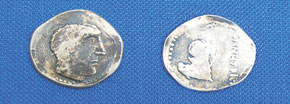 Seleucid silver coins
Seleucid silver coinsTwo silver coins dating back to the rule of Demetrius Nicator (129-125 BC)
1) Weight - 2.9 g; diameter - 21.0-22.0 mm
2) Weight - 2.7 g; diameter - 18.0-19.0 mm
Obverse: features a profile of Demetrius Nicator looking to the right. He is portrayed with a long nose, big chin, narrow forehead and uncombed hair.
Reverse: an image of Athena (the goddess of war according to Greek mythology). She is wearing a Greek helmet on her head, holding a round shield in her right hand and a long spear in her left. She is wearing long, loose clothes. The word ´Dimitrio´ is carved in front of Athena.
The second coin is the same as the first.
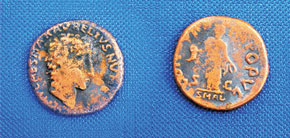 Roman copper coin
Roman copper coinMinted under Roman Emperor Marcus Aurelius (161-180 AD)
Weight - 3.5 g; diameter - 20.0 mm
Obverse: a profile of Emperor Marcus Aurelius looking to the right. He is depicted as a young man with curly hair and a long, straight nose. The coin was minted in the early years of his rule. The image is surrounded with a Latin inscription. Only half of the circular inscription has remained. It reads: ´IMP CAES MAX AVRELIVS NVM…´ (Emperor Caesar Maximus Aurelius)
Reverse: an image of the god Hermes. He holds a curved dagger (or horn or fish) in his right hand and in his left holds an orb, the symbol of power. There is a Latin inscription (SMAL) below the straight line under the god´s feet.
The letter ´S´ can be seen under his right foot and ´C´ under his left. The image is surrounded by a Latin inscription ´…POPVL´, half of which has been erased.
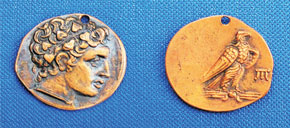 Pontic bronze coin
Pontic bronze coinMinted under Mithridates VI of Pontus (129-63 BC)
Weight - 4.3 g; diameter - 25.0-26.0.
Obverse: Mithridates VI is at the centre in profile, looking to the right. The picture is superb and reminiscent of Greek coins (Macedonian and Seleucid). The king is depicted as a handsome man with big eyes, curly hair and a diadem on his head. The diadem with laurel leaves is placed slightly above his forehead and covers the head. There are six heart-shaped leaves in the upper and lower parts of the diadem. The image is encircled by a frame.
Reverse: an eagle looking to the right. It sits on a sphere with its wings folded. The letter ´T´ is near the legs of the bird and a hole near the top of the coin, which shows that the coin was used as a decorative item.
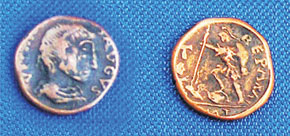 Roman copper coin
Roman copper coinMinted under the Emperor Augustus (27 BC-14 AD)
Weight - 3.8 g; diameter - 12-13.0 mm
Obverse: a profile of Augustus looking to the right. The young, thin Augustus is depicted with a long nose and a diadem on his head. On the left-hand side is the word ´VET´ and on the right the word ´AV_US´.
Reverse: an infantryman is depicted with a helmet on his head, and a shield in his left hand. In his right hand he holds a lance piercing the chest of a man lying on the ground. He also has his right foot on the body of the enemy. The letter ´T´ has been carved into the coin over the head of the wounded warrior. The word ´REPARAT´ has been carved in a circular shape into his right-hand side. Beneath the feet of the infantryman is the half-erased word ´.MT´.
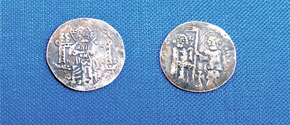 Byzantine silver coin
Byzantine silver coinWeight - 2.8 g; diameter - 19.0-20.0 mm
Obverse: an image of the emperor sitting on his throne. A halo and cross are depicted at the back of his head.
Reverse: an image of Saint Peter presenting a flag to the emperor. There is a cross near his feet and the letters ´DX´ below the flag. There are indistinct inscriptions on the right-hand and left-hand sides of the coin.
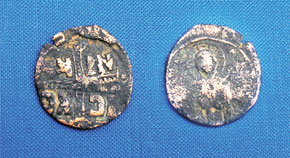 Copper coin from the Sidon satrapy
Copper coin from the Sidon satrapyMinted under Xerxes the Great (also known as Khashayar Shah, a son of Darius I) on behalf of Straton I (also known as Straton the Philhellene for his pro-Greek tendencies)
Weight - 2.9 g; diameter - 21.0-22.0 mm
Obverse: a profile of the king
Reverse: a vessel
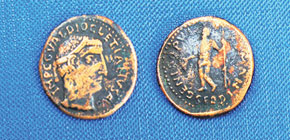 Roman copper coin
Roman copper coinMinted under Emperor Diocletian (284-305 AD)
Weight - 3.2 g; diameter - 24.0
Number of coins: three
Obverse: a profile of Diocletian looking to the right. He is wearing a diadem, fastened at the back of his head. The image is surrounded by a circular inscription: ´IMC_VALDIOCLETIANUS AV_´ (Emperor Caesar Valerius Diocletianus Augustus).
Reverse: an image of Jupiter (king of the gods in Roman mythology) is at the centre. In his left hand he holds a sceptre with a snake twisted around it and in his right an orb, the symbol of power. Jupiter is surrounded by an inscription in Latin which has been partially erased. It reads: ´_ENI POPVL… ROMANI´. The letters ´SERD´ have been engraved beneath Jupiter´s feet. The inscriptions are surrounded by a frame.
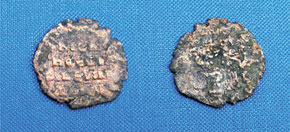 Byzantine copper coin (anonymous)
Byzantine copper coin (anonymous)Weight - 3.4 g; diameter - 25.0 mm.
Obverse: it is so badly corroded that it is indistinct. It has a four-line inscription in Latin of which only the third line is legible. It reads: ´SILEVER´ (silver)
We think that the word ´silver´ was engraved on the coin during a silver crisis, when these coins were put into circulation as silver coins.
Reverse: a large cross is at the centre. The sign has been eroded. The condition of the coin makes chemical cleaning impossible.
These coins discovered during archaeological excavations and exploration show that there was a large city on the territory of Baku even before the birth of Christ.
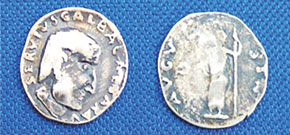 Roman silver coin
Roman silver coinMinted under the Emperor Galba (68-69 AD)
Weight - 3.1 g; diameter - 17.0 mm
Obverse: a bust of the Emperor Galba looking to the right. The re is a circular Latin inscription below the bust. It reads: ´SERVIVS _ALBA CAESARV´ (Servius Galba Caesar Augustus). The frame is not visible.
Reverse: in the centre the Emperor Augustus (Jupiter?) is depicted sitting on his throne with a sceptre in his left hand and an orb in his right. The picture is surrounded by a Latin inscription, only part of which has remained. The word ´AV_V…´ (Augustus) is engraved on the left-hand side and the word ´ST...´ on the right.
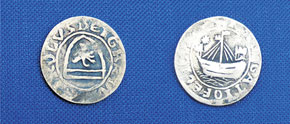 Medieval silver coin from Italy
Medieval silver coin from ItalyWeight - 2.4 g; diameter - 22.0 mm
Obverse: a merchant sailing ship is depicted inside a small circle. Three ropes on each side attach a flag to the mast. Below the flag is the crow´s nest where a lookout would sit. The captain´s cabin is at the stern of the ship while there is an indistinct image in the bow. Waves are clearly visible on the coin. Outside the frame is a circular inscription in Latin, only part of which remains. The inscription reads: ´A. AVI_ATIO _ELIC. A´ The legend is surrounded by a line. Reverse: a coat of arms, which looks like a shield. In the centre of the coat of arms is a bird with its wings extended. A straight line over the bird´s head brings together the right and left sections of the shield. A Latin inscription runs between the big and small circular frames: ´…
ROLUSEI_RADV…´


